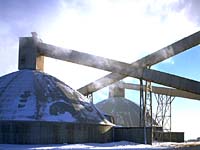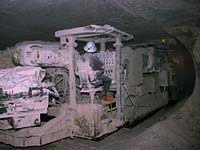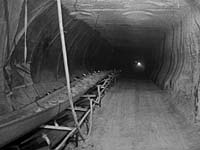
|
|
Mining is an expensive operation. Not only does the minesite need to be built but also the infrastructure such as roads, power lines and communications. |
Types of Mining
There are three basic types of mining in Saskatchewan: Underground Mining
Most underground mines in Saskatchewan produce potash and a few produce uranium and other minerals. In this type of mining, sinking a shaft is the most difficult of mining operations as is illustrated in the potash industry. Most potash mining in Saskatchewan is mined by this conventional method. The ore is extracted from the ground by sinking a shaft and then removing the material by digging. The shafts are about 5 m in diameter and vary from 900 m to 1100 m deep.
In Saskatchewan, potash is found over 1000 m underground. Before sinking can begin, a timber or steel structure , known as a headframe, is built above the ground to carry the cable sheave wheels and provide for efficient dumping of rock and ore. Allan Potash Mine can be seen from miles away by the two huge headframes. One of these structures is just over 65 m high that stands on four enormous straddle legs over the production shaft. Its design eliminates foundation problems by placing the weight of the structure well away from the shaft opening. The shaft is a vertical tunnel dug from ground surface to the mining level. | |||
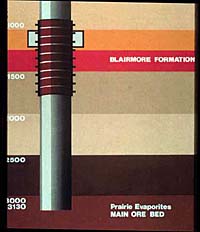
Initially, shaft sinking for potash mining proved difficult due to the presence of waterbearing sand formations under extremely high pressure, between the surface and the mining level. The largest of these is called the Blairmore Formation. When attempts were made to penetrate the Blairmore, the water and sand broke through, flooding the shaft. The problem was solved by freezing the formation and digging through it to the desired depth. Techniques for holding back the water in the shaft after the ice melted involved two systems:
| |||
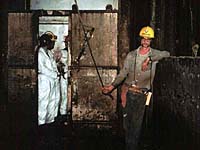
The shaft is constructed to allow equipment and men to enter the underground. In a typical potash mine, the working areas or mine faces may be up to 3 or 4 miles from the shaft. At the Allan Potash Mine, there are approximately 830 km of tunnels. The miners travel to the mining level in a cage down through the shaft. The cage is hoisted by four one-inch cables. It moves at speeds of up to 1300 feet per minute, and has a maximum weight capacity of 34,000 pounds. The cage holds up to 37 adults. The cables can handle 7 times the total maximum allowable weight. A safety device shuts down the cage if a cable becomes slack or is broken. The cage is fully automatic, but can be operated manually. | |||
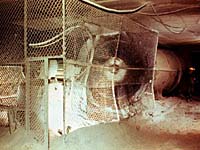
Breathing fresh air 3 miles away from the entrance in the underground mine is not a problem. Fresh air is taken down the shaft at a fast rate and the air is circulated throughout the travelways, shops and production panels using fans, doors and brattice curtain. At the Allan Potash Mine, the main fans are located above ground and the booster fans are underground. Each mining machine has a fan on it and one fan at the start of each conveyor panel. Each panel receives about 23.8 m3/sec of air. | |||

Because the Saskatchewan potash deposits occur in undisturbed, almost horizontal layers 2 m to 3 m thick, mining usually can be carried out on a single level. Saskatchewan's underground potash mines use what is known as the room-and-pillar method to extract ore. The areas mined (rooms), are separated by unmined areas of about the same size (pillars), which provide support for the mine.
| |||
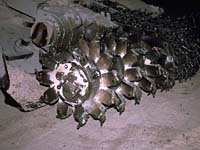
Once the shaft is completed, tunnels are created by huge machines that cut out the ore in the process. Potash ore has a low compressive strength - it tends to deform or creep if under sufficient pressure - so that about 65 per cent of the material in the Saskatchewan mines must be left as pillars. The size of the rooms excavated, however, can be substantial - in some cases, more than 18 m wide and 1500 m long.
| |||
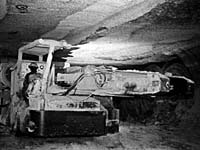
The two main mining machines used for this purpose are the
| |||
On the front end of the each machine are two rotating bits. Because the ore is soft like common salt, these large, self-propelled mining machines with the rotary blades can move into the potash orebody at a speed of about 1 m every three minutes, cutting a swath up to 7 m wide and about 3 m high. The broken ore is automatically transferred to the rear of the machine. Pillars of potash are left intact at frequent intervals to support the roof. Once broken, potash ore is carried to the shafts by conveyer belts, where it is crushed and hoisted to the surface for treatment.
The four-rotor continuous boring machine weighs 218 tonnes (258 tons). It has four cutting rotors, each powered with a 298 kW (400 hp) electric motor and can mine more than 10.8 tonnes (12 tons) of ore per minute or 653 tonnes (720 tons) per hour. The Marietta Miner makes a path 7.9 meters (26 feet) wide and 1.4 meters (8 feet) high.
| |||
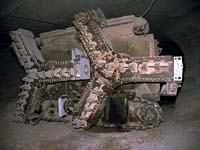
The two-rotor continuous boring machine weighs 136 tonnes (150 tons). It has two 373 kW (500 hp) motors and can mine 9 tonnes (10 tons) of ore per minute or 540 tonnes (600 tons) per hour making a path 3.4 meters (11 feet) high by 5.6 meters (18 feet) wide. The two-rotor machine is used when the potash bed is about 3.4 meters (11 feet) thick. | |||
|
Storage and Transport to the Surface
Ore is stored underground in containers capable of holding several thousand tonnes. Ore is transported from the bin on the conveyor belt to the loading pocket. A measuring bin ensures that the right amount of ore is loaded into the ore skip, a box in the production shaft that holds about 22-23 tonnes. The box or skip is lifted to the surface by the hoist for unloading speeds of 550-1100 meters per minute. The hoist consists of four headropes of lock coil wires running over a friction wheel at the top of the shaft. Attached to the headropes on both sides are two skips, one unloads ore on the surface while the other is being loaded with ore at the bottom.
| |||
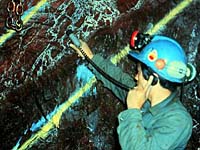
Other minerals mined in Saskatchewan by the underground method are the hardrock metals (copper, zinc and uranium) in the Precambrian Shield. Uranium ore is extracted by drilling and blasting the rock face. When the pieces of ore are small enough, they are transported to the surface and then to the mill area. The hazard of radiation exposure in uranium mining in the enclosed underground mine is controlled by:
| |||
Solution MiningThis method is used to mine minerals (potassium chloride, sodium chloride, sodium sulphate) which dissolve in water. This method enables companies to extract potash at depths too deep to be mined any other way. One mine near Saskatoon uses solution mining, a technique pioneered in Saskatchewan, to recover potash more than 1500 m below the surface. | |||
|
In solution mining, a number of wells are drilled and hot water is pumped down (through bore holes) into the potash bed, where it dissolves the potassium salts, forming large cavities. The potash-bearing solution is pumped back to the surface. The potassium chloride is refined by placing the solution into evaporators. It is then crystallized into the salt and potash. Care must be taken to develop and space cavities so that ground collapse is avoided.
| |||
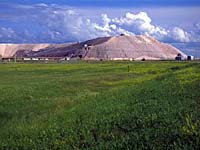
Some of the salt may be transported by pipeline to be refined for commercial use. In all potash plants, crystalline potash is dried and separated into its various particle sizes by a series of screens and chemical processes. The dried, sized-potash is then sent to storage or directly to loading facilities.
| |||

Sodium chloride is mined in a similar manner. Depending on the nature of the deposit and the specific company, sodium sulphate may be mined using solution mining. Water from alkaline lakes (brine containing the mineral sodium sulphate) is pumped into evaporation ponds where natural evaporation concentrates the dissolved salts. The remaining water is allowed to run back into the lake. When the ponded solution cools in autumn, differential crystallization occurs. Sodium sulphate crystals are the first to drop out.
| |||
Some companies mine sodium sulphate directly from the lake bottom in the winter. Since 1989, potash is also recovered in Saskatchewan from a former underground mine that was lost to flooding using a similar process. The potash extraction requires the drilling of intake/outlet wells to pump out a potash-rich brine which is then ponded. The potash from the ponds requires only limited leaching to be upgraded into a commercial product. The cost of bringing potassium salts to the surface by solution mining is cheaper than extracting ore by conventional mining, but this advantage is offset by greater costs in the refining process, which uses natural gas to evaporate the water.
| |||
Surface Mining
This method is best suited to widespread fault seams of such materials such as clay and coal, or compact near-surface bodies such as some uranium. The choice of open pit mining or underground mining in the case of uranium depends on the depth of the ore deposit, how easily the rocks and soil on top of the ore can be removed and, economics. The amount of overburden which must be removed in order to expose the seam varies.
| |||
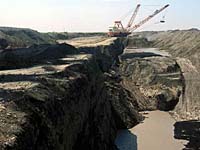
Coal is the best example of surface mining in Saskatchewan. The coal, known as lignite, occurs over much of southern Saskatchewan. A special machine is used for stripping the overburden from the coal. The machine is large and is called a dragline.
| |||
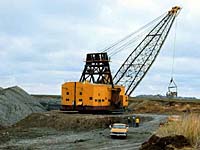
These machines stand more than seventy feet from the ground to the top and the steel boom measures more than 200 feet in length. The overall weight of one may be as much as 2000 tons, or equivalent to the weight of 300 elephants. In Saskatchewan the open pit method has been used for several metallic minerals.
| |||
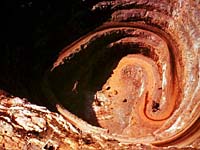
Open cuts are worked progressively deeper until the economic limit is reached, or the material of value runs out. They are wider at the upper rim than at the pit bottom, to ensure safety, and to provide a gradual spiral roadway for trucks and other equipment. Vertical holes are repeatedly drilled thirty feet or more in depth along the levels, which are called benches. After blasting, the broken ore is loaded onto trucks and hauled up the twisting access road for treatment.
| |||
|
In open pit uranium mines, it must first be determined if it is necessary to drill wells into the ore body and surrounding rocks to drain water from the area. Most of the rocks in the Athabasca Basin, where the majority of uranium is located, are sandstone. They are very porous and are saturated with groundwater. If the water table is higher than the ore body, the pumping out of water is necessary in order to lower the water table. This pumping continues throughout the mining operation in order to maintain dry conditions. The next step is the removal of the material (soil, sand and rock) located on top of the ore body. This overburden is removed by using gigantic mechanical shovels and large trucks. The same equipment is used to remove uranium ore from the ground and take it to large storage piles where it waits to be used in the milling process.
|
